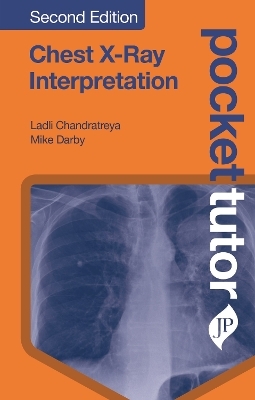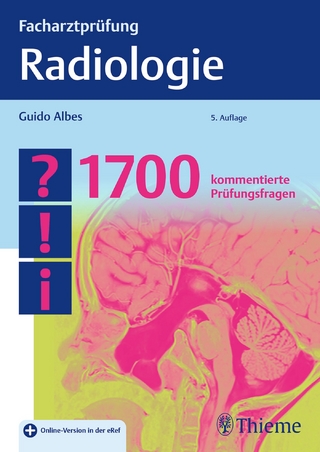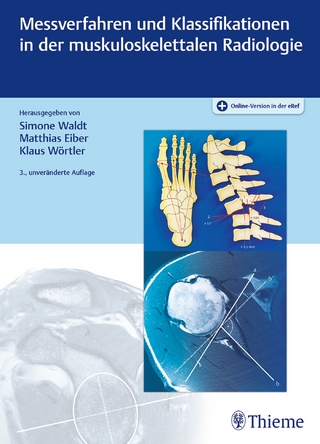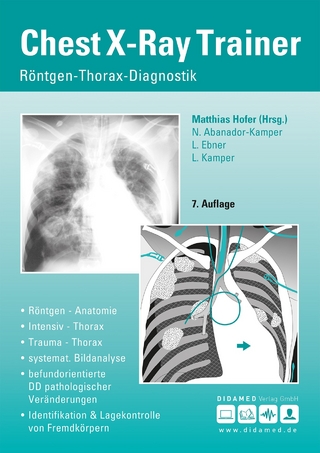
Pocket Tutor Chest X-Ray Interpretation
JP Medical Ltd (Verlag)
978-1-909836-86-0 (ISBN)
Topics reflect information needs stemming from today’s integrated undergraduate and foundation courses:
Common presentations
Investigation options (e.g. ECG, imaging)
Clinical and patient-orientated skills (e.g. examinations, history-taking)
The highly-structured, bite-size content helps novices combat the ‘fear factor’ associated with day-to-day clinical training and provides a detailed resource that students and junior doctors can carry in their pocket.
Key points
Guide to appearance of normal images and abnormal signs helps you navigate imaging results successfully and recognise underlying pathology
Clearly labelled, high-quality images teach you to identify anatomical landmarks and clinical signs
Concise disease descriptions give key facts and cardinal imaging features to look out for in practice
New to this edition: chapter on thoracic trauma and over 50 additional X-ray images, including those of newer medical devices
Previous edition (9781907816062) published in 2012
Ladli Chandratreya MBBS DMRD FRCR Consultant Radiologist Mike Darby BA MBBS MRCP FRCR Consultant Radiologist Both at North Bristol NHS Trust, Bristol, UK
Preface
Chapter 1 First principles
1.1 Physics of X-rays
1.2 Positioning the patient and obtaining the image
1.3 Radiographic densities
1.4 Picture archiving and communication systems: image optimisation and pitfalls
1.5 Errors of perception and interpretation
Chapter 2 Understanding the normal chest X-ray
2.1 Normal chest anatomy
2.2 Normal variants and congenital anomalies
2.3 Artefacts
2.4 Systematic approach to reviewing the chest X-ray
2.5 Postsurgical appearances
Chapter 3 Recognising abnormal signs
3.1 Lung opacities
3.2 Atelectasis
3.3 Reticular opacities
3.4 Pleural abnormalities
3.5 Mediastinal abnormalities
3.6 Diaphragm, subdiaphragmatic area and chest wall abnormalities
Chapter 4 Thoracic infections
4.1 Community-acquired pneumonia
4.2 Hospital-acquired pneumonia
4.3 Active tuberculosis
4.4 Old tuberculosis
4.5 Pneumocystis pneumonia
4.6 Aspergilloma
4.7 Histoplasmosis
Chapter 5 Interstitial lung diseases
5.1 Sarcoidosis
5.2 Idiopathic pulmonary fibrosis
5.3 Asbestosis
5.4 Silicosis
Chapter 6 Bronchogenic malignancy and metastatic disease
6.1 Bronchogenic malignancy
6.2 Metastatic disease
Chapter 7 Pleural disease
7.1 Mesothelioma and other pleural malignancies
7.2 Solitary fibrous tumour of the pleura
7.3 Pleural infection
7.4 Pneumothorax
Chapter 8 Mediastinal disease
8.1 Thymoma
8.2 Hiatus hernia
8.3 Bronchogenic cyst
8.4 Retrosternal goitre
8.5 Pneumomediastinum
8.6 Mitral regurgitation
8.7 Pericardial effusion
8.8 Aortic dissection
Chapter 9 Airway pathology
9.1 Asthma
9.2 Allergic bronchopulmonary aspergillosis
9.3 Chronic obstructive pulmonary disease
9.4 Alpha 1-antitrypsin deficiency
9.5 Bronchiectasis and cystic fibrosis
9.6 Inhaled foreign body
Chapter 10 Pulmonary oedema
10.1 Cardiogenic pulmonary oedema
10.2 Acute lung injury and acute respiratory distress syndrome
Chapter 11 Lines, tubes and other devices
11.1 Nasogastric tubes
11.2 Central venous lines and pacemakers
11.3 Tracheal intubation
11.4 Chest drains
11.5 Other devices in the intensive care situation
11.6 Devices used in lung volume reduction
11.7 Tracheal and bronchial stents
11.8 Embolisation coils in treatment of pulmonary AVM
11.9 Thoracic aortic stent
11.10 Implantable loop recorder
11.11 Left ventricular partitioning device
11.12 Atrial septal defect closure device
11.13 Bariatric surgical treatment
11.14 Oesophageal stent
11.15 Oesophageal variceal embolisation coils
11.16 Transhepatic portosystemic shunt
11.17 Breast implants
11.18 Nipple-areolar prosthesis
11.19 Occipital nerve stimulation system
11.20 Incorrectly placed devices and pitfalls
Chapter 12 Thoracic trauma
12.1 Pneumothorax and haemothorax
12.2 Aortic and vascular injury
12.3 Chest wall injuries
12.4 Pulmonary injury
12.5 Tracheal and bronchial injuries
12.6 Oesophageal tear
12.7 Diaphragmatic rupture
12.8 Pneumoperitoneum
12.9 Penetrating injuries
12.10 Lines and tubes
Index
| Erscheinungsdatum | 10.05.2021 |
|---|---|
| Reihe/Serie | Pocket Tutor |
| Zusatzinfo | 259 Halftones, color; 14 Illustrations |
| Verlagsort | London |
| Sprache | englisch |
| Maße | 113 x 177 mm |
| Themenwelt | Medizinische Fachgebiete ► Radiologie / Bildgebende Verfahren ► Radiologie |
| ISBN-10 | 1-909836-86-9 / 1909836869 |
| ISBN-13 | 978-1-909836-86-0 / 9781909836860 |
| Zustand | Neuware |
| Haben Sie eine Frage zum Produkt? |
aus dem Bereich


